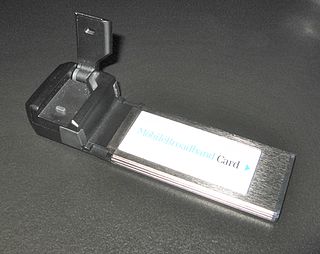Related Research Articles

The Internet is the global system of interconnected computer networks that uses the Internet protocol suite (TCP/IP) to communicate between networks and devices. It is a network of networks that consists of private, public, academic, business, and government networks of local to global scope, linked by a broad array of electronic, wireless, and optical networking technologies. The Internet carries a vast range of information resources and services, such as the interlinked hypertext documents and applications of the World Wide Web (WWW), electronic mail, telephony, and file sharing.

A telecommunications network is a group of nodes interconnected by telecommunications links that are used to exchange messages between the nodes. The links may use a variety of technologies based on the methodologies of circuit switching, message switching, or packet switching, to pass messages and signals.

An intelligent transportation system (ITS) is an advanced application which aims to provide innovative services relating to different modes of transport and traffic management and enable users to be better informed and make safer, more coordinated, and 'smarter' use of transport networks.

A self-driving car, also known as an autonomous car (AC), driverless car, robotaxi, robotic car or robo-car, is a car that is capable of operating with reduced or no human input. Self-driving cars are responsible for all driving activities, such as perceiving the environment, monitoring important systems, and controlling the vehicle, which includes navigating from origin to destination.

Onion routing is a technique for anonymous communication over a computer network. In an onion network, messages are encapsulated in layers of encryption, analogous to the layers of an onion. The encrypted data is transmitted through a series of network nodes called "onion routers," each of which "peels" away a single layer, revealing the data's next destination. When the final layer is decrypted, the message arrives at its destination. The sender remains anonymous because each intermediary knows only the location of the immediately preceding and following nodes. While onion routing provides a high level of security and anonymity, there are methods to break the anonymity of this technique, such as timing analysis.

Telematics is an interdisciplinary field encompassing telecommunications, vehicular technologies, electrical engineering, and computer science. Telematics can involve any of the following:

A computer network is a set of computers sharing resources located on or provided by network nodes. Computers use common communication protocols over digital interconnections to communicate with each other. These interconnections are made up of telecommunication network technologies based on physically wired, optical, and wireless radio-frequency methods that may be arranged in a variety of network topologies.

Vehicular automation involves the use of mechatronics, artificial intelligence, and multi-agent systems to assist the operator of a vehicle such as a car, lorries, aircraft, or watercraft. A vehicle using automation for tasks such as navigation to ease but not replace human control, qualify as semi-autonomous, whereas a fully self-operated vehicle is termed autonomous.
Vehicular ad hoc networks (VANETs) are created by applying the principles of mobile ad hoc networks (MANETs) – the spontaneous creation of a wireless network of mobile devices – to the domain of vehicles. VANETs were first mentioned and introduced in 2001 under "car-to-car ad-hoc mobile communication and networking" applications, where networks can be formed and information can be relayed among cars. It was shown that vehicle-to-vehicle and vehicle-to-roadside communications architectures will co-exist in VANETs to provide road safety, navigation, and other roadside services. VANETs are a key part of the intelligent transportation systems (ITS) framework. Sometimes, VANETs are referred as Intelligent Transportation Networks. They are understood as having evolved into a broader "Internet of vehicles". which itself is expected to ultimately evolve into an "Internet of autonomous vehicles".
Vehicle infrastructure integration (VII) is an initiative fostering research and application development for a series of technologies directly linking road vehicles to their physical surroundings, first and foremost to improve road safety. The technology draws on several disciplines, including transport engineering, electrical engineering, automotive engineering, and computer science. VII specifically covers road transport, although similar technologies are in place or under development for other modes of transport. Planes, for example, use ground-based beacons for automated guidance, allowing the autopilot to fly the plane without human intervention. In highway engineering, improving the safety of a roadway can enhance overall efficiency. VII targets to improve both safety and efficiency.

Mobile broadband is the marketing term for wireless Internet access via mobile networks. Access to the network can be made through a portable modem, wireless modem, or a tablet/smartphone or other mobile device. The first wireless Internet access became available in 1991 as part of the second generation (2G) of mobile phone technology. Higher speeds became available in 2001 and 2006 as part of the third (3G) and fourth (4G) generations. In 2011, 90% of the world's population lived in areas with 2G coverage, while 45% lived in areas with 2G and 3G coverage. Mobile broadband uses the spectrum of 225 MHz to 3700 MHz.
Intelligent vehicular ad hoc networks (InVANETs) use WiFi IEEE 802.11p and effective communication between vehicles with dynamic mobility. Effective measures such as media communication between vehicles can be enabled as well methods to track automotive vehicles. InVANET is not foreseen to replace current mobile communication standards.

Here Technologies is a Dutch multinational group specialized in mapping technologies, location data and related automotive services to individuals and companies. It is majority-owned by a consortium of German automotive companies and American semiconductor company Intel whilst other companies also own minority stakes. Its roots date back to U.S.-based Navteq in 1985, which was acquired by Finland-based Nokia in 2007. Here is currently based in The Netherlands.

Internavi is a vehicle telematics service offered by the Honda Motor Company to drivers in Japan. In the United States, the service is known as HondaLink, or sometimes MyLink. It provides mobile connectivity for on-demand traffic information services and internet provided maps displayed inside selected Honda vehicles. The service began August 1997 and was first offered in the 1998 Honda Accord and the Honda Torneo sold only in Japan starting July 1998. The service received a revision to services offered October 2002, adding traffic information delivery capabilities for subscribers to the Internavi Premium Club, and was optional on most Honda vehicles sold in Japan. VICS was integrated into the service starting September 2003. Membership in the service has steadily grown to exceed 5 million subscribers as of March 2007.
A connected car is a car that can communicate bidirectionally with other systems outside of the car. This connectivity can be used to provide services to passengers or to support or enhance self-driving functionality. For safety-critical applications, it is anticipated that cars will also be connected using dedicated short-range communications (DSRC) or cellular radios, operating in the FCC-granted 5.9 GHz band with very low latency.
Internet censorship circumvention, also referred to as going over the wall or scientific browsing in China, is the use of various methods and tools to bypass internet censorship.

CitizenCOP is a mobile application, developed by the INFOCRATS Web Solutions Pvt. Ltd. and published in October 2012 as freeware. It is developed with the concept to leverage growing use of smart phones for safety of citizens and promote a crime free environment by encouraging voluntary anonymous crime reporting. CitizenCOP app is currently operating in co-ordination of police departments of Bhopal, Indore, Jhansi, Raipur, Noida, Bengaluru and Navi Mumbai. In Raipur, Chief Minister Dr. Raman Singh presided over the launch of CitizenCOP app. For cities where CitizenCOP does not have police association, lite version of the application is working. On 7 March 2016, full version of CitizenCOP was launched in co-ordination of police department of Noida, India. On the occasion of International Women's Day on 8 March 2016, CitizenCOP was launched in Varanasi in co-ordination with the police administration of the city.

Vehicle-to-everything (V2X) is communication between a vehicle and any entity that may affect, or may be affected by, the vehicle. It is a vehicular communication system that incorporates other more specific types of communication as V2I (vehicle-to-infrastructure), V2N (vehicle-to-network), V2V (vehicle-to-vehicle), V2P (vehicle-to-pedestrian), V2D (vehicle-to-device).

Atta ur Rehman Khan is a computer scientist and academician who has contributed to multiple domains of the field. According to a Stanford University report, he is among World's Top 2% Scientists. He is the founder of National Cyber Crime Forensics Lab Pakistan, which operates in partnership with NR3C. He has published numerous research articles and books. He is a senior member of IEEE and ACM.
A smart beach is a beach that incorporates technologies such as AI, automatic drowning detection, riptide detection, wireless communications, sensing, and metasensing often combining aspects of these three purposes: (1) water safety, e.g. accident reduction, (2) public safety, e.g. crime reduction, and (3) operational efficiency, e.g. allocation of lifeguard resources, promotion of tourism, research.
References
- ↑ "Google's Brazil Headache". Businessweek.com. Archived from the original on 27 February 2009.
- ↑ Liu, Qun; Kumar, Suman; Mago, Vijay (2017). "SafeRNet: Safe transportation routing in the era of Internet of vehicles and mobile crowd sensing". 2017 14th IEEE Annual Consumer Communications & Networking Conference (CCNC). Las Vegas, NV, USA: IEEE. pp. 299–304. arXiv: 1805.01162 . doi:10.1109/CCNC.2017.7983123. ISBN 978-1-5090-6196-9. S2CID 19208868.